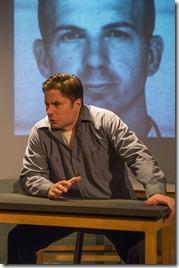
Assassination Theater
Written by Hillel Levin
at MBC, 360 N. State (map)
thru Nov 7 | tix: $39-$49 | more info
Check for half-price tickets
Levin molds Chicago-centric conspiracy into chilling, taut entertainment
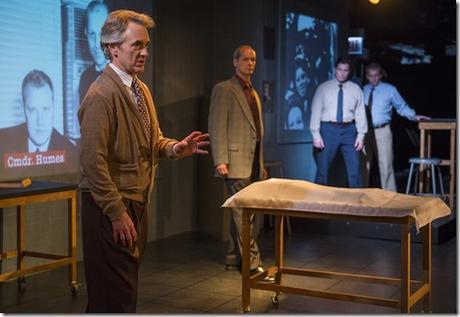
Russell Lane LLC presents
Assassination Theater:
Chicago’s Role in the Crime of the Century
Review by Lawrence Bommer
The concept of the conspiracy theory has been dumped on for decades. Such supposed delusions of persecution are denounced as paranoid pity parties. They imagine threats that are all the direr for being unseen. C.T. practitioners conveniently contrast their all-knowingness with the ignorance of the clueless public.
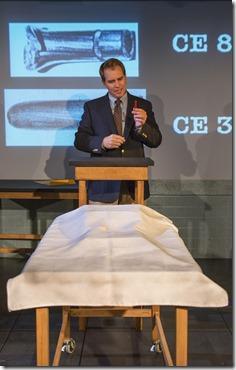
Witness–and I mean that literally–Assassination Theater. Meticulously assembled, illustrated and presented by investigative reporter Hillel Levin, this world premiere has appropriately debuted at the Museum of Broadcast Communications, where it’s authoritatively and entertainingly directed by Kevin Christopher Fox. This 135-minute, two-act delivers a disturbingly convincing “conspiracy theory” about the most maddeningly uncertain event in American history–the assassination of John F. Kennedy on November 22, 1963. Distilling the results of a seven-year search, Levin pulls no punches–and names names–to assert, if not prove, a scary story: This third presidential murder was one of at least three mob “hits” perpetrated by members of the Chicago “outfit,” specifically mob bosses Sam “Momo” Giancana, Tony “Big Fish” Accardo, Carlos Marcello, Peter Licavoli, Tampa’s Santo Trafficante, and lower-level shooters Charles “Chuckie” Nicoletti and Johnny Roselli, along with Dave Yaras and Lenny Patrick.
As Levin puts it, “The assassination was a kind of theater, staged to put the blame on only one actor in what was, in fact, a much larger production.”
Sparing the details (which, given the graphic and awesomely documented projections and interlacing testimony, Levin does not), there were two “operations” here–the underworld and the “overworld.” The first was the Chicago plot to eliminate a President whose brother Bobby had waged war on gangster infiltration of labor unions and legitimate businesses, incarcerating many more Mafiosi than J. Edgar Hoover ever would. The idea was to cut off the head in order to kill the snake. To do this, they found a patsy in Lee Harvey Oswald, who was groomed to look like a Communist stooge, a nut case operating on his own and soon silenced by Jack Ruby, another hoodlum and hanger on. The real and self-confessed gunman accomplice, it’s incredibly revealed, still survives in an Illinois prison.
The second–and unrelated–enterprise was the cover-up, best seen in the whitewashing Warren Commission report and later sanitized Senate committee reports, triumphs of the “suspension of disbelief.” Levin argues, a bit less convincingly, that, fearful of triggering a nuclear war based on Oswald’s Cuban/Commie connection, from the very start the highest authorities in “Camelot,” including the Kennedy clan itself (whose paterfamilias was involved with the Boston mob), wanted to keep the Dallas crime a simple story: The American people had to believe it was a rogue execution, performed by an outcast on the third floor of a book depository.
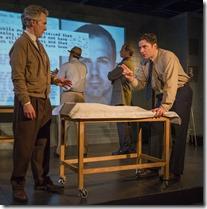
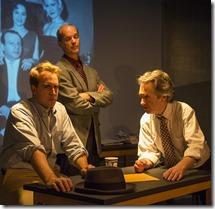
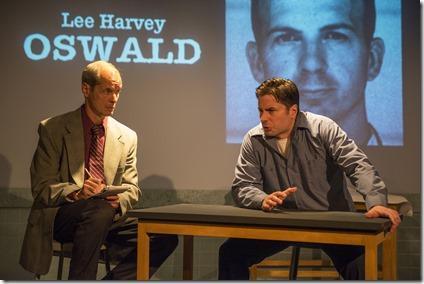
So no shots were fired from the front–the notorious “grassy knoll”–that blew out the brain, just a non-existent bullet in the throat. To preserve this simplified scenario, the body was altered in transport to the autopsy (the brain supposedly switched with another) and the evidence of the original surgeons who saw it ignored and suppressed. The C.I.A. was more hobbled by their ignorance of the assassination’s perpetrators than by their infamous zeal to conceal; anti-Castro exiles were also not part of this picture. But Levin says there was no so-called conspiracy of silence: The press and public just didn’t listen (until now).
To put Cosa Nostra’s hit in context, Levin offers disconcertingly similar evidence that gangsters were also involved in the 1933 attack on Franklin Roosevelt that killed the intended target, hood-hating Chicago mayor Anton Cermak–and in the 1968 shooting of Robert F. Kennedy to insure that the mob-persecuting senator did not become a president like his martyred brother.
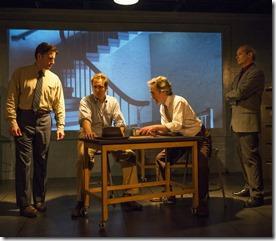
As graphic as the almost unwatchable Zapruder film, Assassination Theater is a brilliantly packaged, fiercely forensic and seamlessly debated indictment of the Chicago mob as brazen history-changers who got away with the biggest murder of the 20th century. (There’s even a complete flow chart of this “lamentable tragedy” in the program.)
You may not credit this cunningly constructed docudrama–similar in urgency and intensity to Emile Zola’s “J’accuse” in the Dreyfus scandal. But it’s well worth a hearing (unfortunately, not congressional). And, since it’s cleverly called “Assassination Theater,” Levin’s potent play works just as entertainingly as art as it does as restorative journalism. If true, it’s a big black eye for the city of Chicago. But truth, like murder, will out. And, of course, you know that–definitely, absolutely, positively–this will not be the end of Kennedy conspiracy theories. Nothing could be more immortal.
Rating: ★★★
Assassination Theater continues through November 7th at the Museum of Broadcast Communications, 360 N. State (map), with performances Wednesday and Thursday 7:30pm, Fridays 8pm, Saturdays 5pm and 8:30pm, Sundays 3pm and 7:30pm. Tickets are $39-$49, and are available by phone (800-838-3006) or online through BrownPaperTickets.com (check for half-price tickets at Goldstar.com). More information at AssassinationTheater.com. (Running time: 2 hours 15 minutes, includes an intermission)
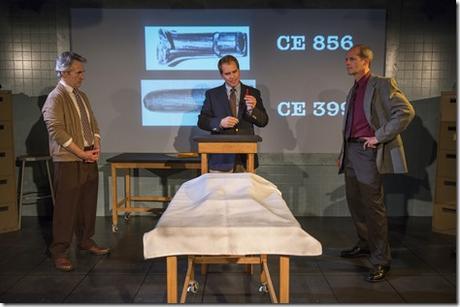
Photos by Michael Brosilow
artists
cast
Michael Joseph Mitchell (Hillel Levin), Mark Ulrich (Zack Shelton), Ryan Kitley (Hoover, LBJ, RFK, Ruby, others), Martin Yurek (Bugliosi, Files, Specter, Warren, others), Michael Joseph Thomas Ward, Jesse Dornan (understudies)
behind the scenes
Kevin Christopher Fox (director), Anthony Churchill (scenic design, media design), Victoria Carot (costume design), Matt Kooi (lighting design), Christopher Kriz (original music, sound design), Richard Lundy (stage manager), Lucy Schuh (assistant stage manager), Patrick Fries (production manager), Mike Pusateri (associate producer), Cecelia Falter (audience services), Madison R. Jones, Caroline Hutchinson (front of house assistants), Warren Levon (sound and light board), Ricky Brown (house mannager), Sadie Tremblay (asst. sound design), Dominic Yao (creative intern), Thomas Baliga (controller), Michael Brosilow (photos)
15-0814

